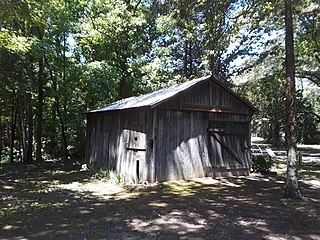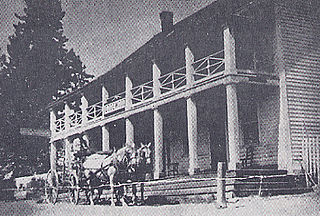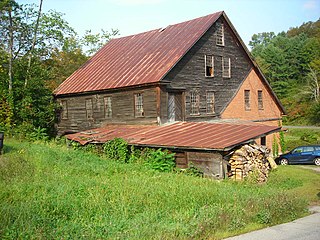
Chesterfield, originally known as Recklesstown, is an unincorporated community located around the intersection of County Route 528 and County Route 677 in Chesterfield Township of Burlington County, New Jersey.

The Appanoose County Courthouse is located in the county seat of Centerville, Iowa, United States. The courthouse was placed on the National Register of Historic Places in 1981. In 1997 it was included as a contributing property in the Courthouse Square Historic District.

The Cook Blacksmith Shop is a former blacksmith shop in Ponca, Nebraska, United States that today is a museum.
A. Newton Farm is a historic home and farm complex located at Orleans in Jefferson County, New York. The farmhouse was built about 1870 and is a small, modest 1+1⁄2-story Greek Revival building with a gable front, prominent cornice returns, a northside wing, and a modern kitchen ell on the rear. Also on the property are a hay barn, blacksmith's shop, toolshed, pig barn, milk and ice house, hay and heifer barn, and horse barn.
Old Stone Shop is a historic commercial building located at Lyme in Jefferson County, New York. It was built in 1838–1839 and is a 1+1⁄2-story, four-by-two-bay gable-ended building with foundation and walls of coursed quarry-dressed limestone, trimmed in dressed limestone. It was built as a double blacksmith shop and exhibits the finest commercial masonry architecture in the town of Lyme.

Potter's Tavern is located at 49–51 Broad Street in the city of Bridgeton in Cumberland County, New Jersey, United States. Built in 1770, it was added to the National Register of Historic Places on September 10, 1971, for its significance in architecture, communications, and politics. The building was documented by the Historic American Buildings Survey (HABS) in 2003.

Mixter Blacksmith Shop is a historic blacksmith shop located at Warrensburg, Warren County, New York. It was built about 1840 in the Greek Revival style to house a commercial operation and modified about 1890 in the Queen Anne style to accommodate mixed use activities. It is a two-story building built into a slope. It is constructed of load-bearing local granite and topped by a medium pitched roof clad in raised seam metal.
The IOOF Lodge No. 355, also known as the Clements Odd Fellows Hall, in Clements, California is a two-story brick building that was listed on the National Register of Historic Places in 2007.

Grooms Tavern Complex is a historic tavern located at Grooms Corners in Saratoga County, New York. The complex consists of the tavern, a wagon and blacksmith shop, and a frame privy. The tavern building was built about 1825 and is a 2-story, timber-framed, gable-roofed building in a vernacular Federal style. It consists of a main block with 1+1⁄2-story, frame kitchen wing in the rear. When expanded to two stories in the 1840s, a Greek Revival style cornice was added. The building was partially remodeled in the late 19th and early 20th centuries. The tavern building was also operated as a general store. The wagon and blacksmith shop was constructed in the 1840s and is a 2-story, rectangular, timber-framed building with a gable roof in the Greek Revival style.

Hickman Blacksmith Shop and House, also known as the Chas. C. Connell Roofing, Gutter, and Siding Co. and Jeffrey and Pamella Seemans House, is a historic home and blacksmith shop located at Marshallton, New Castle County, Delaware. The shop was built about 1899, and is a rectangular, frame, 1+1⁄2-story building on a high stone foundation. The house was built about 1860, and is a side-passage plan, frame, 2-story dwelling on a stone foundation, with Stick trim and modest interior finish.

Jackson Blacksmith Shop is a historic blacksmith shop located near Goochland, Goochland County, Virginia. It was built in 1932, and is a one-story, rectangular, pole structure, shed-type building. It measures 16 feet by 24 feet and has a gable roof. The shop remains in operation.

Friday's Station, on US 50 between Kingsbury Grade and Loop Road in Stateline, Nevada, is a two-story wood-frame white building built as a Pony Express station and inn in 1860. In 1986, it was known as Park Cattle Company Residence and was listed on the National Register of Historic Places. The two-story wood-frame white building is visible from U.S. Route 50 near the California-Nevada border at Stateline, Nevada.

The John S. Dominy House is a historic house located at 605 Pearl Street in Sabula, Iowa.

The Hayward and Kibby Mill, also known as the Tunbridge Mill, is a historic industrial facility on Spring Road in Tunbridge, Vermont. It includes a substantially complete water-powered 19th-century grist mill dating back to 1820, with a later sawmill added about 1870. It is one of the few surviving water-powered mills in the state, and is believed to be the only one featuring both a sawmill and grist (grain) mill. It was listed on the National Register of Historic Places in 1992.

The Old Stone Blacksmith Shop is a historic building on Vermont Route 30 in Cornwall, Vermont. Probably built in the late 18th century, it is a rare example in the state of a stone blacksmith shop, with a documented history of more than century's use for the purpose. It was listed on the National Register of Historic Places in 1975.

The Bigler Building, also known as the Riegel Blacksmith Shop, is a historic building located in Clermont, Iowa, United States. The simple, single-story brick structure was built in about 1906 by Fred Bigler who operated the local lumberyard and was a contractor. This property had long been the location for a blacksmith shop. Burkhard Riegel, a German immigrant, opened his shop in this building in 1931. He rented the space until he bought the building from Bigler's widow in 1946. After his death in 1990, the Clermont Historical Society acquired the building for a living history museum, and it contains its original blacksmithing equipment and furnishings. It was listed on the National Register of Historic Places on June 9, 1995.

The John B. Robarge Duplex is a historic multi-unit residence at 58-60 North Champlain Street in Burlington, Vermont. Built 1878–79, it is one of the city's few examples of an Italianate two-family house. It was listed on the National Register of Historic Places in 2005.

The August H.J. and Justena Lange Farmstead Historic District is an agricultural historic district located northeast of La Porte City, Iowa, United States. It was listed on the National Register of Historic Places in 1997. At the time of its nomination it consisted of 16 resources, which included seven contributing buildings, two contributing structures, one contributing objects, three non-contributing buildings, and three non-contributing structures. The farmstead was developed from 1887, when the Lange's took possession of the property, and 1916 when they moved into La Porte City. They had a general farming operation here that was augmented by August's specialized skill as a blacksmith. The farmstead was organized spatially with the domestic buildings on the west side of Spring Creek Road and the farming operation on the east side.

The Thresher Mill is a historic industrial facility on West Barnet Road in Barnet, Vermont. First developed in 1836, it was the last water-powered mill to operate on the Stevens River, lasting into the late 20th century. The property, which includes an original mill dam and a surviving 1872 mill building, as well as archaeological sites of other industrial buildings, was listed on the National Register of Historic Places in 1996. It is now styled Ben's Mill, and is a local museum.

The Red Ball Garage, also known as the Ed Neil Garage, is a historic building located in Swedesburg, Iowa, United States. The building is located along what was known as the Military Road. Because of the marshy land in the area, wagons and buggies had to be pulled out of the mud. In 1913 the road became a part of the Red Ball Route, a highway that linked the Minneapolis/St. Paul area with St. Louis. It received its name from the highway signs used to mark the route. The highway was paved from 1929 to 1930, and later became U.S. Route 218 until it was moved to the east as a four lane-highway in the 1990s.

















